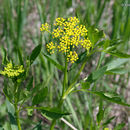pt-BR
nomes no trilho de navegação


Zizia aurea (golden alexanders, golden zizia) is a flowering herbaceous perennial plant of the carrot family Apiaceae. It is native to eastern Canada and the United States, from the eastern Great Plains to the Atlantic Coast. It is named for Johann Baptist Ziz, a German botanist.[3]
Zizia aurea grows to 40 to 75 centimetres (16 to 30 in) tall but can sometimes grow taller. The leaves are 8 cm (3+1⁄4 in) long and 5 cm (2 in) wide. They are attached to the stems alternately. Each leaf is compound and odd-pinnate, with leaflets that are normally lanceolate or ovate with serrated edges. The root system consists of a dense cluster of coarse fibrous roots.[4]
It blooms from May to June. Its flowers are yellow and grow in a flat-topped umbel at the top of the plant. Each flower is only 3 mm (0.12 in) long and has five sepals, five petals, and five stamens. Each flower produces a single 3 to 4 mm (0.12 to 0.16 in) long, oblong fruit (schizocarp) containing two seeds. In the fall both the leaves and the fruit turn purple.[4]
Golden Alexander is native to the United States and Canada. It grows from New Brunswick to Saskatchewan, south to Florida and Texas, and west to Montana.[5] It is found in a broad variety of habitats, such as moist black soil prairies, openings in moist to mesic woodlands, savannas, thickets, limestone glades and bluffs, power line clearings in woodland areas, abandoned fields, and wet meadows.[4][6] It can tolerate dry summers even though it prefers wet habitats.[4] It is hardy in USDA zones 4–9.
It is a host plant for the caterpillars of the black swallowtail (Papilio polyxenes asterius) and Ozark swallowtail (Papilio joanae) butterflies.[4] Females of the mining bee species Andrena ziziae are oligolectic on Zizia aurea—they eat only its pollen.[6] Dozens of species of bees, flies, wasps, butterflies, and other insects visit the flowers of Zizia aurea for its nectar.[6]
Zizia aurea (golden alexanders, golden zizia) is a flowering herbaceous perennial plant of the carrot family Apiaceae. It is native to eastern Canada and the United States, from the eastern Great Plains to the Atlantic Coast. It is named for Johann Baptist Ziz, a German botanist.
El Alexanders de oro (Zizia aurea W.D.J. Koch) en una planta herbácea perenne de la familia Apiaceae.
Posee un tallo erecto, a menudo varios, que se encuentran ramificados en la parte superior. Su altura suele oscilar entre los 45 y 90 cm de altura. Las hojas, dentadas, son de 2 a 5 cm de largo. Necesita unas cantidades normales de agua, y preferiblemente, zonas con iluminación no directa.
Su periodo de floración se suele situar entre los meses de mayo y junio, siendo el color de la inflorescencia amarillo. La umbela puede presentar de 9 a 25 pedicelos, los cuales miden aproximadamente de 5 a 15 cm.[1]
Se localiza en Estados Unidos y Canadá, en praderas húmedas, laderas enselvadas abiertas, zanjas, y a lo largo de corrientes de agua.
Los nativos americanos utilizaban esta planta como remedio para aliviar fiebres y dolores de cabeza. Esta planta produce vómitos, y puede ser considerada como tóxica.
El Alexanders de oro (Zizia aurea W.D.J. Koch) en una planta herbácea perenne de la familia Apiaceae.
Zizia doré
Le Zizia doré (Zizia aurea) est une plante de la famille des Apiaceae. Il est originaire de l'Est de l'Amérique du Nord; il se rencontre dans tous les états des États-Unis compris entre le Dakota du Nord et le Texas, puis du Maine jusqu'à la Floride. Au Canada, il occupe le sud des provinces du Manitoba, de l'Ontario, du Québec, du Nouveau-Brunswick et de la Nouvelle-Écosse. Son grand potentiel horticole fait qu'il a été exporté, et s'est même naturalisé sur plusieurs continents, jusqu'en Australie.
Le zizia doré est une plante vivace de 40 à 80 cm de haut; il préfère les champs un peu humides, rivages, sols calcaires ou argileux, mais il est tolérant à la sécheresse où il croît en petites colonies; il préfère les milieux ensoleillés à partiellement ombragés. Sa floraison d'un jaune-doré s'étale de mai à juin; ses ombelles de 9 à 25 rayons sont robustes et ascendantes. Son nectar attire les papillons et autres insectes. La germination des graines s'effectue avec un fort pourcentage[1].
Zizia doré
Le Zizia doré (Zizia aurea) est une plante de la famille des Apiaceae. Il est originaire de l'Est de l'Amérique du Nord; il se rencontre dans tous les états des États-Unis compris entre le Dakota du Nord et le Texas, puis du Maine jusqu'à la Floride. Au Canada, il occupe le sud des provinces du Manitoba, de l'Ontario, du Québec, du Nouveau-Brunswick et de la Nouvelle-Écosse. Son grand potentiel horticole fait qu'il a été exporté, et s'est même naturalisé sur plusieurs continents, jusqu'en Australie.